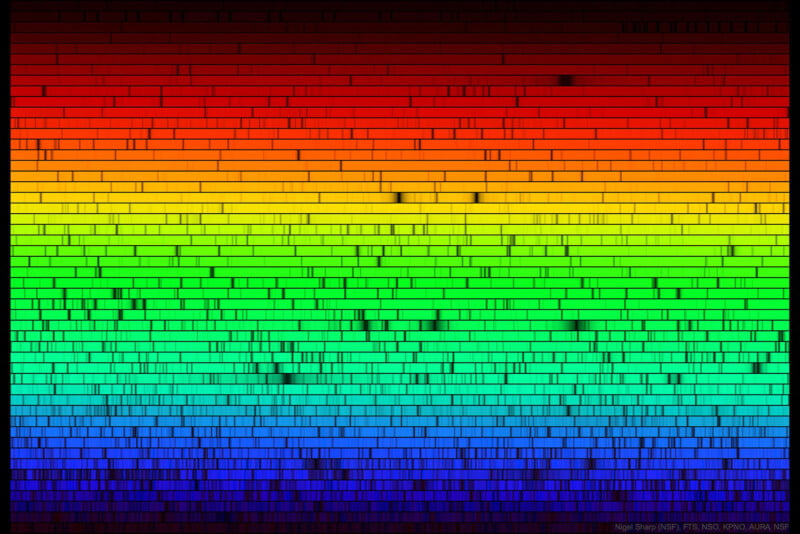This Spectral Image Shows How the Sun Emits Light of Nearly Every Color

A recent NASA Astronomy Photo of the Day selection showcases all the visible colors of the Sun. The beautiful image was created by the McMath-Pierce Solar Observatory and shows that while the Sun often appears bright white, it emits light of nearly every color.
As seen on DIY Photography, the vibrant photo holds a lot of crucial information about the Sun, and the activity on and around the star. It’s worth mentioning that while NASA APOD featured the photo recently, it first appeared on NASA in 2017.
The black sections in the image tell a story of absorption.
“The dark patches in the featured spectrum arise from gas at or above the Sun’s surface absorbing sunlight emitted below,” explains NASA. Further, “Since different types of gas absorb different colors of light, it is possible to determine what gasses compose the Sun.”
Given that the Sun is of vital importance to life on Earth, it stands to reason that scientists have identified all of the Sun’s spectral absorption lines. However, that’s not the case.
Some elements have been discovered thanks to the solar spectrum, including Helium, which was discovered in 1868 on a solar spectrum. Described as “the first alien element,” helium was discovered on Earth about a decade after scientists found it in spectral analysis of the Sun.
Aided by a spectroscope, which operates like a prism, absorption lines long puzzled scientists. The black lines interrupting colors were confounding for decades. It wasn’t until 1859 when Gustav Kirchoff and Robert Bunsen observed that when certain chemicals were heated in Bunsen’s burner, bright emission lines appeared at the precise wavelengths where dark lines appeared in the Sun’s spectrum.
“Emission lines refer to the fact that glowing hot gas emits lines of light, whereas absorption lines refer to the tendency of cool atmospheric gas to absorb the same lines of light. When light passes through gas in the atmosphere some of the light at particular wavelengths is scattered resulting in darker bands. These lines came to be known as ‘spectral lines’ and were cataloged by heating common elements until they produced light and measuring the wavelengths emitted,” explains Khan Academy.
While technology has dramatically changed since then, the beautiful spectrum image created at the McMath-Pierce Solar Observatory also relies upon a prism-like device.
The Sun Isn’t Yellow
Despite frequently being shown in illustrations as being yellow, orange, or even red, the Sun is “essentially all colors mixed together, which appear to our eyes as white,” explains the Stanford Solar Center. This is shown not only by using prisms but by looking at a rainbow, which show the light from the Sun separated into different wavelengths.
As for why the Sun appears yellow, orange, or red during sunrise or sunset, that’s because the Sun’s shortest wavelengths, green, blue, and violet, are scattered by the Earth’s atmosphere at that angle. Only the red, yellow, and orange light makes it to people’s eyes through the atmosphere.
It’s also a common misconception that the Sun’s peak output is yellow, but as seen in the multispectral photo, the largest section is green, and yellow is a relatively minor player. “[The Sun] emits most of its energy around 500 nm, which is close to blue-green light. So one might say that the sun is blue-green!” writes Lou Mayo for NASA.
Image credits: Nigel Sharp (NSF), FTS, NSO, KPNO, AURA, NSF